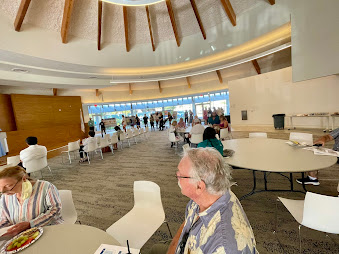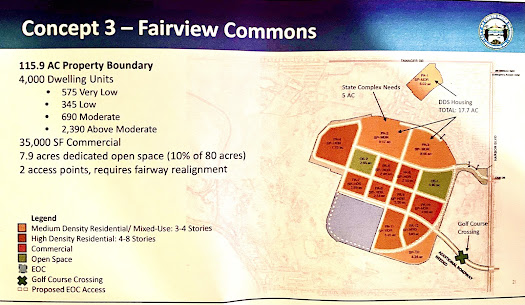CHRIS THINKS HE'S RIGHT - BUT HE'S VERY WRONG!
THE "RIGHT' - In his latest angry post he complains that California has gone "too blue" - that the Democrats control everything and that's not good. Generally, I agree with him. He quantifies his feelings pretty clearly and I cannot refute the numbers he, a former math teacher, presents. He blames an uninformed electorate for blindly choosing to elect Democrats rather than consider more conservative candidates. He is correct that California, under the heavy hand of the Democrat Party, continues headed in the wrong direction, which is causing many folks to bail out and head for more conservative pastures, leaving the rest of us to deal with much higher costs, both financially and socially.
HOWEVER - THE "WRONG" - In my view he gets it very wrong when, while citing what he feels is bad about Costa Mesa's government - the city council is too heavily weighted toward the liberal side of things - he suggests that the local voters should arbitrarily abandon their collective wisdom and blindly vote for candidates simply because they are conservative. This is a HUGE mistake, in my view.
"BALANCE" IS GOOD, BUT - McEvoy suggest we need more "balance" on the city council - that there should be 3 conservatives and 3 liberals plus the 7th person to be chosen by those six. Of course, under our current municipal code that's not possible. More on that later.
STEPHENS OR PETERS? - When my friend suggests that the voters toss aside our current mayor, John Stephens and mayor pro team, Jeffrey Harlan, simply because they are liberal and replace them with two individuals that, although "conservative", leave MUCH to be desired as candidates for office in my city, he goes too far. James Peters, who McEvoy suggests should replace our directly-elected mayor, brings virtually nothing to the party except a strong allegiance to former president Donald Trump. That's not enough for me, a lifelong Republican, to choose him over Stephens - a man who has served our city proudly and with distinction for many years. Of course, I don't always agree with Stephens, but he always hears my viewpoint and I ALWAYS know he has only the best interests of our city at heart.
HARLAN OR PETTIS? - Similarly, McEvoy suggests Harlan - a very bright public servant who brings a thoughtful, articulate, civilized demeanor along with his intelligence and very relevant professional experience to the role of a councilman - be replaced by Jeff Pettis, a person Harlan crushed in the last election. And for good reason. Pettis persists in demonstrating on his YouTube channel, that he is an ignorant, partisan hack who really has no clue about municipal governance. Heck, through the last election cycle he didn't even know where the Costa Mesa Senior Center was located!
ERETH OR BULEY? - McEvoy suggests that partisan lawyer Mike Buley - a man with no public service experience and has likely never even attended a city council meeting - is a better choice for the District 1 seat than current Planning Commission Chairman Adam Ereth. That is ridiculous! Not only does Dr. Ereth bring strong academic credentials to the council, he has demonstrated his competence and leadership as chairman of the Planning Commission and comes from a family with a demonstrated public service mindset. I'd vote for him if I could.
HIS MEMORY IS SHORT - McEvoy's memory is very short. He forgets the "bad old days" - just how our council became so heavily-tilted to the liberal side of things. He forgets that the previous iteration of the council was very strongly tilted to the conservative side, when Jim Righeimer and Steve Mensinger and their sycophants controlled the show. He forgets the partisan, misguided, heavy-handed governance under those guys! He forgets their bogus (and illegal) attempt to lay off nearly half (over 200) "miscellaneous" employees - an act that resulted in one of those employees, Huy Pham, jumping to his death from the roof of City Hall! He forgets the disdain Righeimer and Mensinger had for municipal employees that caused a third of our police officers to bail out - seeking jobs elsewhere or taking early retirement. He forgets that they refused to let then-chief Tom Gazsi recruit much-needed replacements for more than 8 months - an act that very likely contributed to Gazsi finding a new job at the Port of Los Angeles. When the current crop of "conservative" candidates yap about public safety they conveniently forget the jeopardy the Righeimer/Mensinger regime created.
"QUICK-PITCHING THE BALLOT MEASURE" - McEvoy forgets how, when forced by a lawyer to create a methodology to elect council members by district to provide more representation for the Latinos in our community - many of whom are McEvoy's neighbors - Righeimer and Mensinger quick-pitched the process and forced onto the ballot a "six council members elected by district and a directly-elected mayor" scheme - which not a single person who attended any of the meetings expressed a preference for - instead of the preferred "5 council members elected by district who would choose the mayor from among themselves". He forgets how that scheme backfired and resulted in 3 members of the Latino community being elected to the council - Manuel Chavez, Arlis Reynolds and Andrea Marr - and Katrina Foley (whom they had summarily ousted from the mayor's seat a few months earlier) was overwhelmingly chosen by the voters as our first directly-elected mayor over appointed incumbent Sandra Genis. Former conservative mayor Allan Mansoor was crushed by Reynolds in the District 5 race, but remained on as an "at-large" councilman until the next election. That election slammed the door on the Republican influence on city politics - a very good thing, in my view.
DON'T FOLLOW - THINK! - As you mark your sample ballots, or as you prepare to mail your completed ballot in, think about the decisions you will be making. Our city is being effectively governed by a liberal majority and to attempt to force three incompetent Republicans onto the dais to provide "balance" accomplishes nothing except to perpetuate the decline of my Republican Party in Orange County. Find better candidates - those who can actually bring an intellectual, persuasive discussion to the process, unlike the current lamebrain, lazy, incompetent Don Harper, who has chosen to bail out after nearly 4 years of sleepwalking through his job, not contributing to the sound governance of our city. We don't need another version of him. Every ballot counts, so make your informed choices, keeping in mind the future of our city is in your hands.























